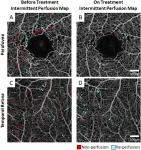(Press-News.org) A pioneering study by UCL scientists has discovered the presence of a harmful inflammatory protein in patients with symptomatic tuberculosis (TB).
Researchers say, by targeting the IL-17 cytokine, a component produced naturally by the immune system in response to infection, excessive and damaging lung inflammation caused by TB may be significantly reduced to help speed up patient recovery.
TB is an infection caused by the bacterium Mycobacterium tuberculosis and is the leading cause of death from infections worldwide. The World Health Organisation estimates that 1.4 million people died of TB disease worldwide in 2019.
Explaining the experimental study, lead author Dr Gabriele Pollara (UCL Division of Infection & Immunity), said: "For most people the body's immune response to TB is a vital defence strategy to contain the infection, but when disease develops it can worsen symptoms, cause lung damage, and promote transmission of the infection to others.
"For some time, we have thought that the body's own immune response to TB could in fact be causing more tissue damage and promoting the spread of infection - but we did not know how this happens.
"In this study, we found that in patients with active TB, the immune system may be responding pathologically (causing harm), and that this immune response was not present in those with latent TB, who have controlled the infection."
As part of the study, published in Science Translational Medicine, medical centres in the UK, South Africa and Peru recruited patients to take a tuberculin skin test (TST), which involves injecting a small amount of fluid (called tuberculin) into the skin on the lower part of the arm. Raised skin or swelling, detected 48 hours later, denotes a positive test.
Subsequent tests confirmed 48 of the people recruited had symptomatic TB and 191 people had asymptomatic/latent TB. Genome-wide transcriptional profiling of biopsies of the TSTs was then carried out to make detailed measurements of the immune response.
Researchers discovered that samples from patients with symptomatic TB disease showed increased activity of IL-17 cytokine, which is an immune response known to cause tissue damage in other inflammatory conditions.
Dr Pollara, an NIHR Clinical Lecturer, added: "This new research has identified for the first time the nature of these potentially harmful immune pathways. We show that a specific immune pathway, the IL-17 cytokine, is present exclusively in the immune response of patients with TB disease, but not those who never develop symptoms.
"This is a fascinating finding because IL-17 cytokine responses cause disease and tissue damage in other inflammatory conditions, such as psoriasis and ankylosing spondylitis. In both conditions, drugs that block the IL-17 pathway are highly effective at improving patient symptoms, and so our findings indicate these same drugs could also be beneficial in treating patients with TB disease."
For over 50 years, the mainstay of treatment for tuberculosis has been antibiotics that kill bacteria. Although effective, this strategy carries a lot of challenges; treatment involves taking four antibiotics and lasts for at least six months, and its efficacy is being increasingly challenged by rising rates of antibiotic resistance. Therefore, developing new approaches to treating TB disease is an urgent global research priority.
Senior author, Professor Mahdad Noursadeghi (UCL Division of Infection & Immunity) said: "Our work has the potential to make a step change in care of TB patients, providing a rationale for targeting specific immune components, alongside the conventional use of antibiotics.
"We anticipate this would accelerate clinical recovery, interrupt transmission between individuals and reduce the time antibiotic treatment is required. More broadly, these findings open the door to an exciting new frontier in treating infectious diseases.
"By understanding immune responses to infections that are detrimental, it justifies the use of focused 'host-directed' drugs that complement the action of antibiotics. In turn this strategy has the potential to limit disease severity, shorten antibiotic courses, and therefore mitigate against the rise in antibiotic resistance worldwide."
Next steps
Researchers aim to devise a clinical trial to test whether drugs targeting IL-17 cytokine in patients with symptomatic TB reduce symptoms and improve patient outcomes.
INFORMATION:
This work was supported by grants from the Wellcome Trust, Medical Research Council, Academy of Medical Sciences and NIHR Biomedical Research Centre at University College London Hospitals.
In a time of a global crisis such as the ongoing COVID-19 pandemic, it is easy to note how people move through different phases to buckle up for such unprecedented and arduous times.
In the very beginning of the pandemic last year, we observed "an epidemic of fear", where it was all about the calamitous nature of a totally unknown virus and its worrying contagiousness and mortality rate. A few months later, with lockdown and restrictions already in place across the world, the fear was replaced by "an epidemic of explanations", where people even in their naivety, started to seek a sense of comfort by ...
Climate change, a pandemic or the coordinated activity of neurons in the brain: In all of these examples, a transition takes place at a certain point from the base state to a new state. Researchers at the Technical University of Munich (TUM) have discovered a universal mathematical structure at these so-called tipping points. It creates the basis for a better understanding of the behavior of networked systems.
It is an essential question for scientists in every field: How can we predict and influence changes in a networked system? "In biology, one example is the modelling of coordinated neuron activity," says Christian Kühn, professor of multiscale and stochastic dynamics ...
Can expert commissions develop solutions for controversial issues that will enjoy broad democratic support? A team of researchers from the Institute for Advanced Sustainability Studies (IASS) has analysed the work of Germany's "Coal Exit Commission" using a set of new criteria. While the authors view positively the Commission's success in reaching a compromise, they criticise its failure to deliver an outcome that promotes the common good, particularly with respect to the high cost of the coal exit and its unambitious contribution towards Germany's climate goals, as well as the lack of public participation.
On 29 April 2021, Germany's Federal Constitutional Court ruled that the provisions of the Climate Protection Act (2019) are incompatible ...
Only one in three fertilizations leads to a successful pregnancy. Many embryos fail to progress beyond early development. Cell biologists at the Max Planck Institute (MPI) for Biophysical Chemistry in Göttingen (Germany), together with researchers at the Institute of Farm Animal Genetics in Mariensee and other international colleagues, have now developed a new model system for studying early embryonic development. With the help of this system, they discovered that errors often occur when the genetic material from each parent combines immediately after fertilization. This is due to a remarkably inefficient process.
Human somatic cells typically have 46 chromosomes, which together carry ...
Ophthalmologists at New York Eye and Ear Infirmary of Mount Sinai have created a new technique to evaluate patients with sickle cell retinopathy and assess the disease before it progresses and leads to permanent vision loss.
Using optical coherence tomography (OCT) angiography--an advanced imaging system that captures the motion of red blood cells in blood vessels non-invasively--the researchers discovered that sequential imaging of affected retinal blood flow in sickle cell patients can help assess how the disease is progressing and how effective their treatment is for reducing focal vascular strokes. Their study was published ...
Porcupines are frequently traded across Asia, and Indonesia, home to five species, is no exception. They are targeted for a number of reasons: their meat as an alternative source of protein, their bezoars consumed as traditional medicine, and their quills used as talismans and for decorative purposes.
A new study examining seizure data of porcupines, their parts and derivatives in Indonesia found a total of 39 incidents from January 2013 to June 2020 involving an estimated 452 porcupines. The research was published in the open-access, peer-reviewed journal Nature Conservation.
There are no harvest quotas for any porcupine species in Indonesia, which makes all hunting and trade in porcupines illegal. Of the five species found in the country, only the Sunda porcupine (Hystrix javanica) ...
COLUMBUS, Ohio - The symptoms of grief people feel for a loved one facing a life-limiting illness fluctuate over time, a new study found - suggesting that individuals can adjust to their emotional pain, but also revealing factors that can make pre-loss grief more severe.
Researchers examined changes in the severity of pre-loss grief symptoms in people whose family members had either advanced cancer or dementia.
The study is the first to document pre-loss grief at two points in time, and found that about 70% of participants' symptoms decreased over a month. However, compared to initial symptoms reported by participants, ...
An analysis of historical medical records found that men who were prenatally exposed during early gestation to the Dutch famine of 1944-1945 were 30 percent more likely to be overweight with a Body Mass Index of 25 or over at age 19, compared to a similar group not exposed to the famine. Professor L. H. Lumey at Columbia University Mailman School of Public Health led the study, which is published in the International Journal of Obesity. The study confirms evidence on the health risks of prenatal famine exposure, which also includes diabetes and schizophrenia.
The mechanism by which famine exposure raises the risk for later excess weight is still unknown. The researchers speculate that famine exposure could lead to changes in DNA methylation that stimulate being overweight. Or that surviving ...
MRSA skin infections are often treated with intravenous injection of antibiotics, which can cause significant side effects and promote the development of resistant bacterial strains. To solve these problems, researchers at Karolinska Institutet in Sweden are developing a microneedle patch that delivers antibiotics directly into the affected skin area. New results published in Advanced Materials Technologies show that the microneedle patch effectively reduces MRSA bacteria in the skin.
MRSA (methicillin resistant Staphylococcus aureus) skin infections are potentially lethal, ...
A new approach to tackling viruses by targeting the 'control centre' in viral RNA could lead to broad spectrum anti-viral drugs and provide a first line of defence against future pandemics, according to new research at the University of Birmingham.
In a new study, published in Angewandte Chemie, researchers have shown how this approach could be effective against the SARS-CoV-2 virus responsible for the COVID-19 pandemic. Earlier modelling and in vitro analysis by the team and published in Chemical Science has also shown effectiveness against the HIV virus.
Professor Mike Hannon, from the University of Birmingham's School of Chemistry, is co-lead author ...


